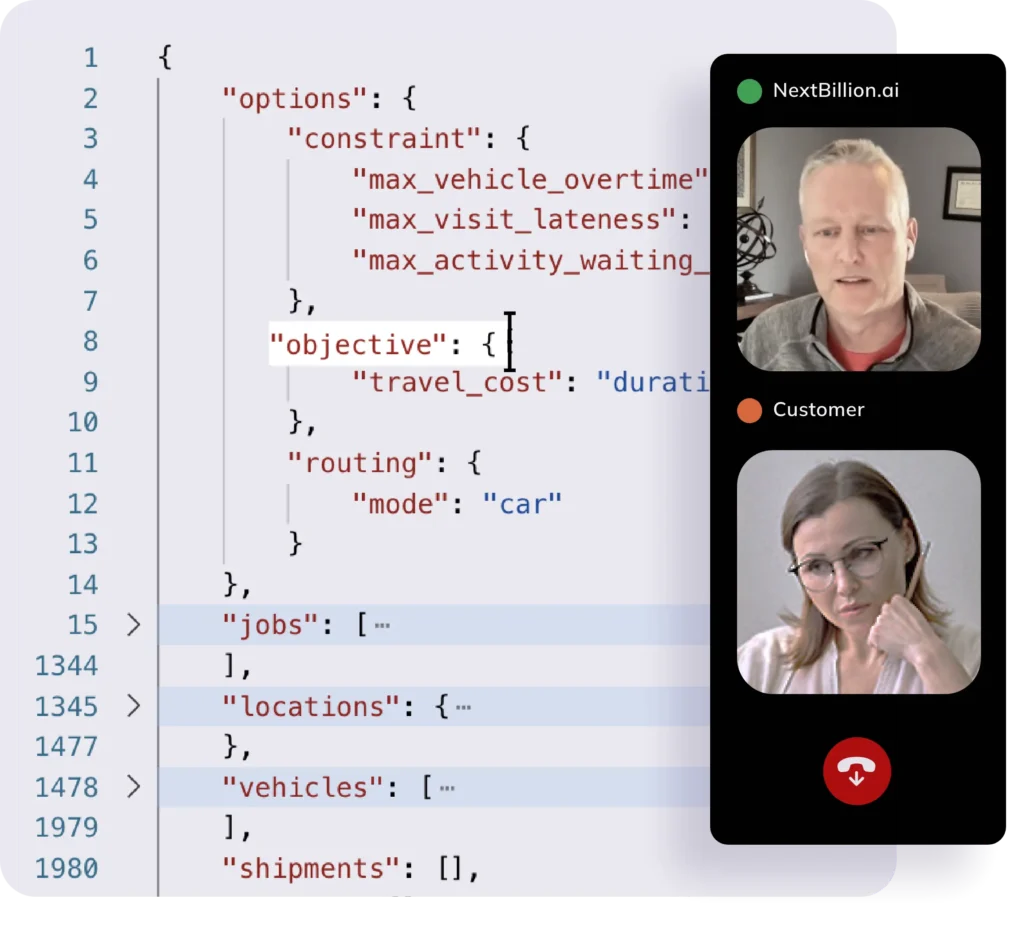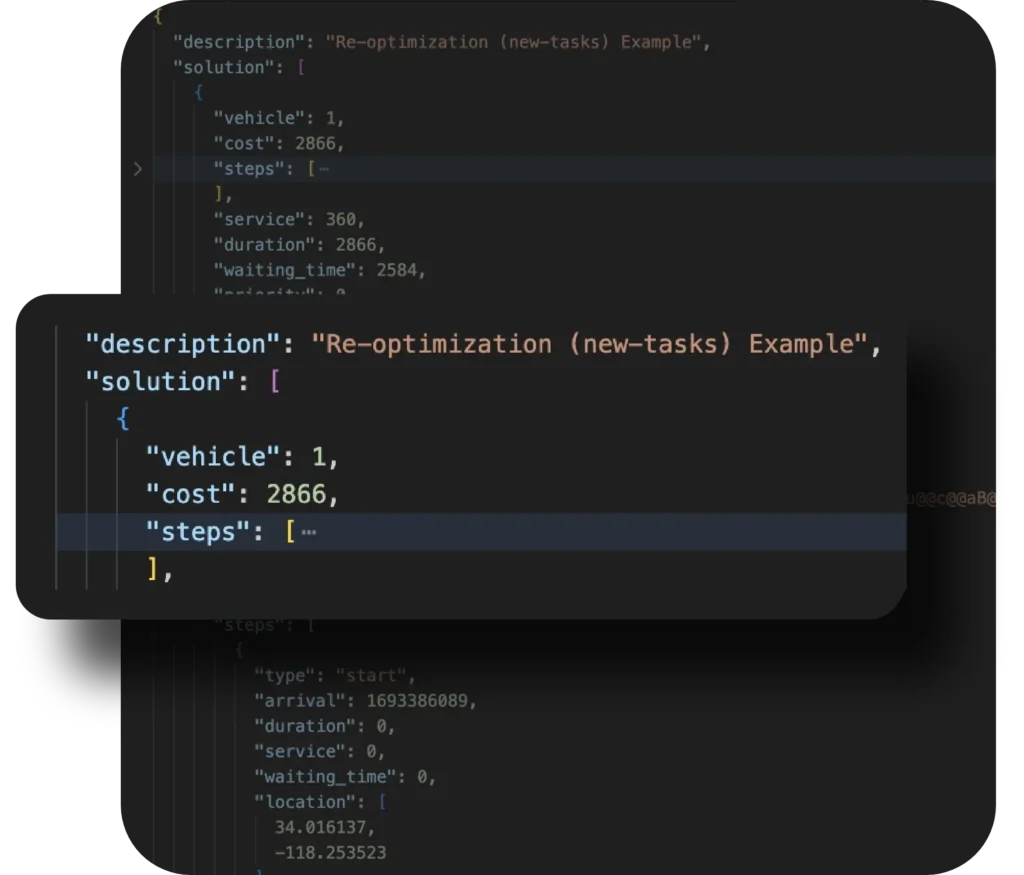
Table of Contents
Dynamic route optimization is changing the logistics industry when sustainability, speed and efficiency matter most. Imagine a world where goods are moved with minimal environmental impact, field techs arrive on-site faster, and delivery trucks don’t get stuck in traffic.
The need for smarter, more flexible routing solutions has never been greater. Dynamic routing can transform transportation by using real-time data and advanced algorithms. This article will get you started with dynamic route optimization in 2024.
What is Dynamic Route Optimization?

Dynamic route optimization uses advanced algorithms and real-time data to continuously update and improve delivery and transportation routes. Unlike static routing, which is pre-determined, dynamic routing adapts to changing conditions such as traffic congestion, road closures, and delivery time windows.
Dynamic route optimization’s flexibility ensures that vehicles take the most efficient routes, leading to significant cost savings and improved customer satisfaction.
Importance of Dynamic Route Optimization
The significance of dynamic route optimization extends across multiple facets of logistics and transportation:
- Cost Savings: By optimizing routes in real-time, companies can significantly reduce fuel consumption and vehicle maintenance costs. This leads to substantial financial savings over time.
- Efficiency: Enhanced routing efficiency means faster deliveries, fewer delays, and improved utilization of fleet resources. This can lead to increased productivity and better service levels.
- Environmental Impact: Optimized routes contribute to lower fuel usage and emissions, helping companies reduce their carbon footprint. This aligns with global sustainability goals and demonstrates corporate responsibility.
Applications of Dynamic Route Optimization
Dynamic route optimization finds applications in a variety of industries, each reaping distinct benefits:
Logistics and Transportation: Companies managing delivery fleets use dynamic routing to ensure timely, cost-effective deliveries, optimizing routes for maximum efficiency.
E-commerce: Online retailers leverage dynamic route optimization to meet tight delivery schedules, enhance customer satisfaction, and provide quicker shipping options.
Healthcare: Medical supply and pharmaceutical companies depend on optimized routes for the timely delivery of critical supplies and medications, ensuring they reach their destinations without delay.
Public Transportation: City transit systems implement dynamic routing to adjust bus and shuttle routes based on real-time passenger demand and traffic conditions, improving service reliability and efficiency.
Field Services: Businesses with field technicians, such as utilities and repair services, use dynamic optimization to minimize travel time between service calls, increasing overall productivity and reducing operational costs.
Dynamic route optimization transforms how businesses manage transportation and logistics. It’s a flexible and powerful tool to improve efficiency, cut costs and reduce environmental impact across many industries.
Key Components of Dynamic Route Optimization

Algorithms for Dynamic Route Optimization
Dynamic route optimization relies on advanced algorithms and specialized software solutions to calculate the most efficient routes in real time. Key types of algorithms include:
- Genetic Algorithms: These algorithms mimic natural selection processes to iteratively find optimal or near-optimal solutions for route planning. They are particularly effective for solving complex optimization problems.
- Machine Learning: Machine learning algorithms analyze historical data and learn from patterns to make predictive routing decisions. These algorithms can adapt over time, improving their accuracy and efficiency.
- Heuristic Algorithms: These algorithms provide quick, practical solutions to routing problems by using rules of thumb or educated guesses, making them suitable for scenarios where computational speed is essential.
- Linear Programming: This mathematical approach helps in optimizing a given objective, such as minimizing travel time or fuel consumption, subject to a set of constraints like delivery time windows or vehicle capacity.
Several software solutions incorporate these algorithms, offering user-friendly interfaces and robust analytics to help businesses implement dynamic route optimization effectively.
NextBillion.ai’s Route Optimization API is among the popular and advanced options available today, offering advanced dynamic route optimization capabilities for various industries.
Data Requirements
Accurate data is the backbone of dynamic route optimization. Key data requirements include:
Real-Time Traffic Information: Access to up-to-date traffic conditions is crucial for rerouting vehicles to avoid congestion and delays. This data is typically sourced from GPS systems and traffic monitoring services.
Vehicle Capacity: Understanding the load capacity of each vehicle ensures that routes are planned efficiently, avoiding overloading and underutilization.
Delivery Windows: Knowing the specific time frames within which deliveries must be made allows for precise route planning, ensuring timely arrivals and enhanced customer satisfaction.
Historical Data: Analyzing past delivery performance, traffic patterns, and route efficiency helps in refining algorithms and making more accurate predictions.
Technology Integration
For dynamic route optimization to be effective, it must seamlessly integrate with various technologies:
GPS: Global Positioning System technology provides real-time location tracking of vehicles, enabling dynamic rerouting based on current positions and traffic conditions.
IoT Devices: Internet of Things (IoT) devices, such as sensors and telematics units, collect data on vehicle performance, cargo conditions, and driver behavior. This data feeds into the optimization algorithms to improve decision-making.
Mobile Applications: Driver apps facilitate communication and real-time updates, allowing drivers to receive new routes, report issues, and confirm deliveries.
Cloud Computing: Cloud-based platforms offer scalable solutions for data storage, processing, and real-time analytics, making it easier to handle large volumes of data and perform complex computations.
By combining these key components, dynamic route optimization systems deliver significant improvements in route efficiency, cost savings, and overall operational effectiveness.
How to Implement Dynamic Route Optimization in Your Business?
Implementing dynamic route optimization can significantly enhance your business’s efficiency, save time, and reduce costs. Here’s a step-by-step guide to integrating Dynamic Route Optimization with NextBillion.ai’s Route Optimization API into your operations.
Step 1: Assess Your Business Needs
- Identify Objectives: Determine the specific goals you aim to achieve with route optimization, such as reducing fuel costs, improving delivery times, or enhancing customer satisfaction.
- Analyze Current Operations: Evaluate your current routing and delivery processes to identify areas that need improvement.
- Define Constraints: List all constraints that need to be considered, such as vehicle capacity, delivery time windows, and vehicle availability.
Step 2: Gather and Prepare the Data
- Collect Data: Gather all necessary data about your jobs (stops/places to visit), vehicles (delivery trucks, vans, etc.), and shipments (pickup and delivery tasks).
- Format Data: Ensure that your data is formatted correctly to be used as input for the API. This includes details like location coordinates, time windows for deliveries, and vehicle capacities.
Step 3: Set Up the API Integration
- API Access: Obtain API access credentials from NextBillion.ai.
- Development Environment: Set up your development environment to interact with the NextBillion.ai Route Optimization API.
Step 4: Set Up Your Optimization Request
- Create Your Data: Organize all the information about your delivery stops, vehicles, and tasks. Make sure you have details like addresses, delivery time frames, and vehicle capacities ready.
- Specify Your Goals: Clearly outline what you want to achieve with route optimization, such as minimizing travel distance, reducing fuel costs, or ensuring timely deliveries.
- Add Special Requirements: If you have any specific needs, like avoiding toll roads or prioritizing certain deliveries, make sure to include these in your setup.
- Advanced Features: Utilize advanced features like re-optimization and order sequencing by configuring the solutions and relations objects.
Step 5: Submit Your Optimization Request
- Send Your Information: Use the information you prepared to create a request for the optimization. Think of it like placing an order where you provide all the necessary details.
- Receive Confirmation: Once your request is submitted, you will receive a unique ID. This ID helps you track the progress of your optimization request.
Step 6: Retrieve Optimization Results
- Check the Status: Use the unique ID you received to check if your optimization request is complete. It’s like tracking a package with a tracking number.
- Get Your Results: Once the optimization is done, you can access the detailed, optimized routes and delivery schedules.
Step 7: Continuous Improvement
Regularly update your data and rerun optimizations to ensure your routes stay efficient as conditions change.
Take advantage of additional features offered by NextBillion.ai to further refine and improve your routing strategies.
By following these steps, you can seamlessly integrate dynamic route optimization into your business operations, making your delivery processes more efficient and cost-effective.
Future Trends in Dynamic Route Optimization

AI and Machine Learning
The integration of artificial intelligence (AI) and machine learning (ML) is revolutionizing the field of dynamic route optimization. These technologies enable systems to learn from historical data and continuously improve routing decisions.
AI algorithms can predict traffic patterns, identify the most efficient routes, and adapt to changing conditions in real-time. Machine learning models analyze vast amounts of data to uncover hidden patterns and trends, allowing for more accurate and efficient route planning.
As AI and ML continue to evolve, we can expect even more advanced and intelligent route optimization solutions that enhance operational efficiency and reduce costs.
Autonomous Vehicles
The rise of autonomous vehicles is poised to significantly impact dynamic route optimization. Self-driving technology promises to eliminate human errors, reduce accidents, and ensure precise adherence to optimized routes.
Autonomous vehicles can communicate with each other and with traffic management systems to coordinate movements and avoid congestion. This level of coordination and precision will lead to more efficient traffic flow, reduced travel times, and lower fuel consumption.
As autonomous vehicles become more prevalent, dynamic route optimization systems will need to adapt to manage mixed fleets of human-driven and autonomous vehicles, ultimately leading to a more seamless and efficient transportation network.
Sustainability
Sustainability is becoming an increasingly important focus for businesses and governments alike. Dynamic route optimization plays a crucial role in reducing carbon footprints by minimizing fuel consumption and emissions.
Optimized routes reduce the number of miles traveled, leading to less fuel usage and lower greenhouse gas emissions. Additionally, dynamic route optimization can prioritize eco-friendly routes, such as avoiding areas with high pollution levels or choosing routes with fewer stop-and-go traffic conditions.
As environmental regulations tighten and consumers demand greener practices, the role of route optimization in promoting sustainability will continue to grow, helping businesses achieve their environmental goals while maintaining operational efficiency.
These future trends highlight the transformative potential of dynamic route optimization. With advancements in AI, the emergence of autonomous vehicles, and a growing emphasis on sustainability, the future of route optimization looks promising, offering smarter, greener, and more efficient transportation solutions.
Getting Started with Dynamic Route Optimization
Dynamic route optimization is no longer a nice to have but a must-have in today’s logistics and transportation landscape. By using advanced algorithms, real-time data and technology, businesses can see significant improvements in efficiency, cost savings and environmental impact. As we’ve seen, the future of route optimization is being shaped by AI, autonomous vehicles and a growing focus on sustainability, so it’s a great time to get on board
If you want to implement dynamic route optimization and want the best solution in the market, try NextBillion.ai’s Route Optimization API. Designed to handle complex constraints and customizable to your needs, NextBillion.ai is your partner in maximizing efficiency, saving time and reducing costs. Whether you have one vehicle or an entire fleet, our API will transform your routing process so you stay ahead of the game.
Start your journey towards smarter, more efficient routing with NextBillion.ai’s Route Optimization API and experience the future of logistics today.
About Author
Shivangi Singh
Shivangi is a seasoned Technical Writer with a passion for simplifying technical concepts. With over 5 years of experience, she specializes in crafting clear and concise documentation for various technical products and platforms.












